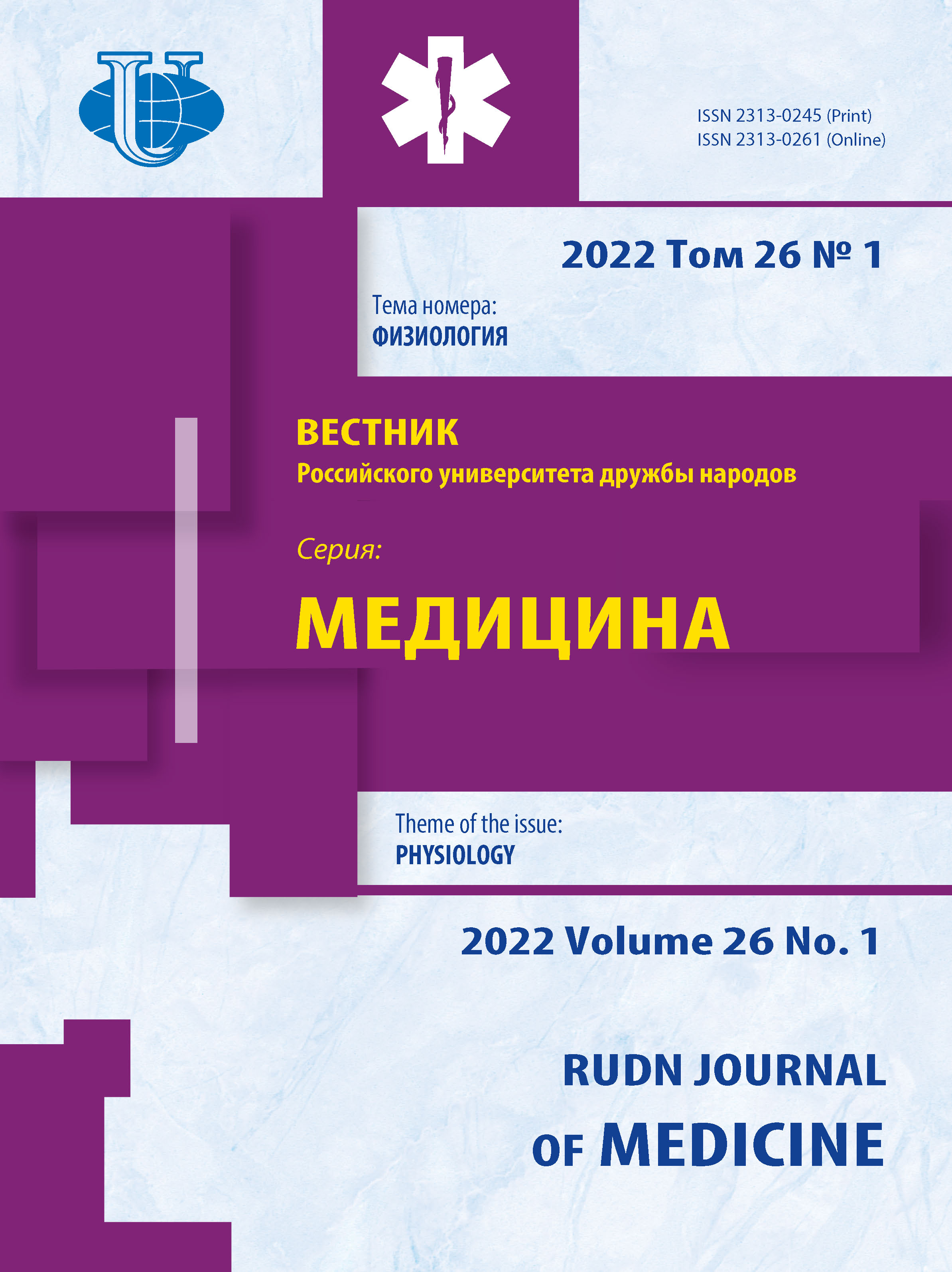The rabbits retina functional state after exposure to low-frequency ultrasound: electroretinogram indicators analysis
- Authors: Vafiev A.S.1,2
-
Affiliations:
- Bashkir State Medical University
- CJSC «Optimedservice»
- Issue: Vol 26, No 1 (2022): PHYSIOLOGY
- Pages: 62-68
- Section: Physiology
- URL: https://journals.rudn.ru/medicine/article/view/30537
- DOI: https://doi.org/10.22363/2313-0245-2022-26-1-62-68
Cite item
Full Text
Abstract
Relevance. Currently, several groups of scientists are working on the implementation of low-frequency ultrasound in surgery of the retina and vitreous body. But there are not enough articles on the study of the functional activity of the retina when exposed to this type of energy. Electrophysiological research methods make it possible to analyze and evaluate the safety, effectiveness of surgical interventions, the effect of new drugs at the level of neurons and visual pathways. The electroretinography method makes it possible to record the bioelectrical activity of retinal neurons during light stimulation during dark and light adaptation. The aim of the study is to carry out a comparative analysis of the aand b-wave indices of the rabbit electroretinogram after experimental removal of the vitreous body using low-frequency ultrasound and mechanical action. Materials and Methods. Experiments were carried out in two groups of Chinchilla rabbits (n = 40). In the experimental group, surgery to remove the vitreous body was performed using low-frequency ultrasound, in the control group a fragmentator with guillotine mechanism was used. Before and after the surgery (1, 7, 14, 30 days) an electroretinogram was recorded, the parameters of the amplitude and latency of the aand b-waves were measured. Results and Discussion. In both groups, a sharp decrease in all parameters was observed on day 1. Later, on the 7th day, the dynamics of the latency of aand b-waves slightly decreased than the preoperative values. On the 14th day after the exposure, the amplitude and peak latency of the aand bwaves in both groups remained at the same level as on the 7th day. On the 30th day, the indicators increased, which indicates the restoration of the functions of photoreceptors and Mueller cells in both groups. There were no statistically significant differences between the study groups at all periods of the study. Conclusion. The use of low-frequency ultrasound for vitreous removal can be considered safe and has prospects for further development and application.
Keywords
About the authors
Aleksander S. Vafiev
Bashkir State Medical University; CJSC «Optimedservice»
Author for correspondence.
Email: a.s.vafiev@gmail.com
ORCID iD: 0000-0002-0541-3248
Ufa, Russian Federation
References
- Charles S, Calzada J, Wood B. Vitreous Microsurgery. Lippincott Williams & Wilkins, a Wolters Kluwer business. 2011. 259 p.
- Saxena S, Meyer CH, Ohji M, Akduman L. Vitreoretinal surgery. London: Jaypee Brothers Medical Publishers. 2012. 442 p.
- Ilyukhin ОЕ, Frolov МА, Ignatenko КV. Functional results of surgical treatment of retinal detachment. RUDN Journal of Medicine. 2020:24(2):156—162. doi: 10.22363/2313-0245-2020-24-2-156-162
- Khalimov TA. Features of angiogenesis in eye diseases. RUDN Journal of Medicine. 2021;25(2):106—113. doi: 10.22363/23130245-2021-25-2-106-113
- Pavlidis M. Two-Dimensional Cutting (TDC) Vitrectome: In vitro flow assessment and prospective clinical study evaluating core vitrectomy efficiency versus standard vitrectome. Hindawi Journal of Ophthalmology. 2016:1—6. doi: 10.1155/2016/3849316
- Mohamed S, Claes C, Tsang CW. Review of Small Gauge Vitrectomy: Progress and Innovations. Hindawi Journal of Ophthalmology. 2017:1—9. doi: 10.1155/2017/6285869
- Pastor-Idoate S, Bonshek R, Irion L, Zambrano I, Carlin P, Mironov A. et al. Ultrastructural and histopathologic findings after pars plana vitrectomy with a new hypersonic vitrector system. Qualitative preliminary report. PLOS one. 2017;4:1—16. doi: 10.1371/journal.pone.0173883
- Aznabaev BM, Dibaev TI, Mukhamadeev TR, Vafiev AS, Shavaliev IKh. Twenty-five gauge ultrasonic vitrectomy: experimental and clinical performance analysis. Retina. 2020;7:1443—1450. doi: 10.1097/IAE.0000000000002863
- Stanga PE, Pastor-Idoate S, Zambrano I, Carlin P, McLeod D. Performance analysis of a new hypersonic vitrector system. Plos One. 2017;12:1—15. doi: 10.1371/journal.pone.0178462
- Wuchinich D. Ultrasonic vitrectomy instrument. Physics Procedia. 2015;63:217—222. doi: 10.1016/j.phpro.2015.03.035
- Aznabaev BM, Dibaev TI, Mukhamadeev TR, Vafiev AS, Shavaliev IKh. Ultrasonic vitrectomy: performance evaluation in experimental and clinical conditions. Practical Medicine. 2018; 6(4):56—62.
- Aznabaev BM, Dibaev TI, Mukhamadeev TR, Rakhimov AF. Experimental study of the performance of an ultrasound vitreotome. Cataract and refractive surgery. 2017;17(2):48—51.
- Zueva MV. Fundamental ophthalmology: the role of electrophysiological research. Bulletin of ophthalmology. 2014;6:28—29.
- Mukhamadeev TR, Ahmadeev RR. Light-induced total electrical activity of retina in models of particular disorders in vivo amd in vitro. Saratov journal of medical scientific research. 2018;14(4):903—909.
- Koshelev DI. Correlation of parameters of electroretinogram, axial length of the eye and visual acuity in emmetropia in humans. PhD Thesis. St. Petersburg. 2004. 20 p.
- Kulikov AN, Sosnovskiy SV, Nikolaenko EN. Analysis of the dynamics of retinal and optic nerve electrogenesis after vitrectomy for complicated cataract surgery. Ophthalmologicheskie vedomosti. 2018;11(3):34—47. doi: 10.17816/OV11334-47
- Akhmadeev RR, Timerbulatov IF, Koshelev DI, Evtushenko EM, Timerbulatova MF. Critical Frequency of Flicker Merging and Visual Potentials under Computer Load. RUDN Journal of Medicine. 2019;23(2):178—186. doi: 10.22363/2313-0245-201923-2-178-186
















